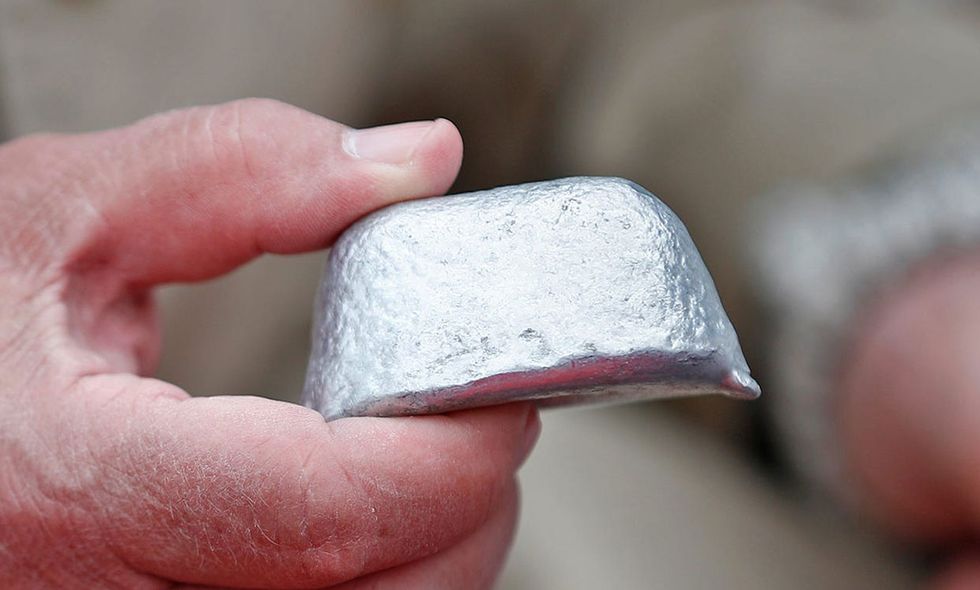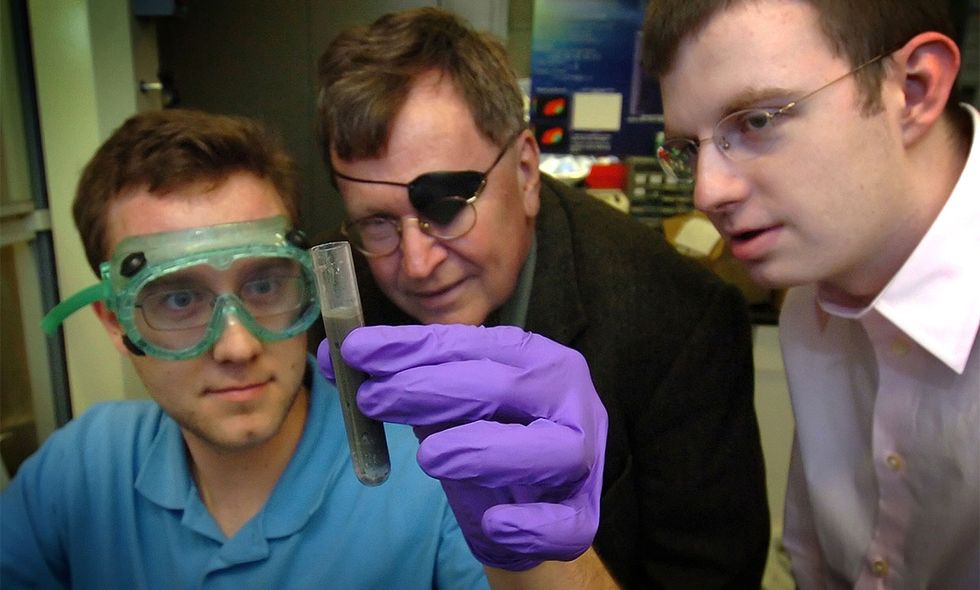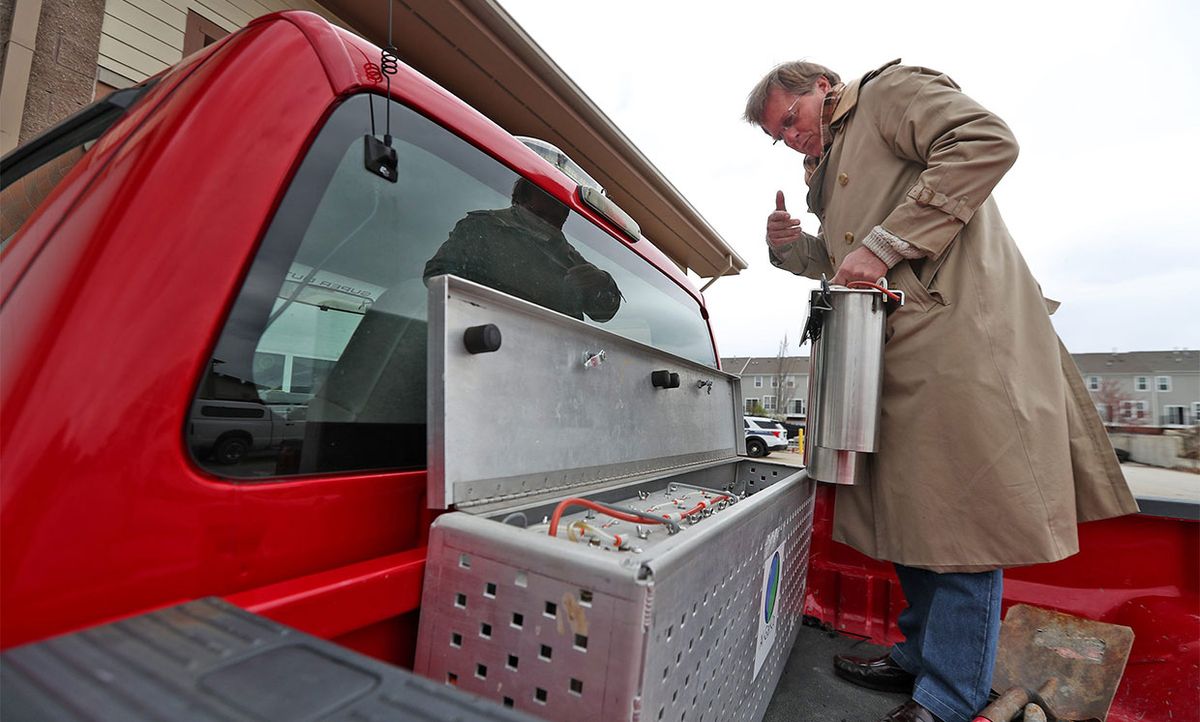The city of Carmel, Ind., has trucks for plowing snow, salting streets, and carrying landscaping equipment. But one cherry-red pickup can do something no other vehicle can: produce its own hydrogen.
A 45-kilogram metal box sits in the bed of the work truck. When a driver starts the engine, the device automatically begins concocting the colorless, odorless gas, which feeds into the engine’s intake manifold. This prevents the truck from guzzling gasoline until the hydrogen supply runs out. The pickup has no fuel-cell module, a standard component in most hydrogen vehicles. No high-pressure storage tanks or refueling pumps are needed, either.
Instead, the “hydrogen-on-tap” device contains six stainless steel canisters. Each contains a 113-gram button of an aluminum and gallium alloy. A small amount of water drips onto the buttons, causing a chemical reaction that splits the oxygen and hydrogen contained in the water. The hydrogen releases, and the rest turns into aluminum oxide, a waste product that can be recycled to create more buttons. Back in the garage, the driver can replace spent canisters with news ones to replenish the hydrogen supply.

AlGalCo—short for Aluminum Gallium Co.—has spent 14 years refining the technology, which is based on a process developed by distinguished engineer Jerry Woodall. In 2013, AlGalCo partnered with the Carmel Street Department to build a prototype for one of the city’s Ford F-250 trucks. In tests, the red pickup has seen a 15 percent improvement in gas mileage and a 20 percent drop in carbon dioxide emissions.
“When the hydrogen burns, it burns without any emissions,” says Kurt Koehler, founder and president of the Indianapolis-based startup. “So you have better fuel mileage and lower [total] emissions.”
Carmel, a city of 92,000 people, sits about 26 kilometers north of Indiana’s capital city. Mayor James Brainard recently agreed to outfit five municipal trucks with “version 5.0” of the hydrogen device, in an effort to reduce the city’s carbon footprint. Brainard told the Indianapolis Starthe city expects to spend US $5,000 on the retrofits. Koehler says the trucks should be running by the end of June, even with delays related to the COVID-19 pandemic.
Carmel’s pickups will be the latest entrants in the growing global market for hydrogen-powered vehicles. Automakers Honda, Hyundai, and Toyota are ramping up production of their hydrogen-fuel-cell passenger cars, while the delivery companies FedEx and United Parcel Service are experimenting with hydrogen vans. Indiana engine maker Cummins has developed fuel-cell systems for heavy-duty trucks, including four vehicles now hauling groceries in Norway.
Traditional hydrogen models offer two key advantages over battery-powered competitors. Refilling the fuel tank takes only minutes, versus hours to recharge batteries, and hydrogen vehicles can generally travel longer distances before needing to refuel. Yet in the United States and globally, hydrogen refueling infrastructure remains sparse, and vehicles themselves are generally more expensive than battery versions. Most hydrogen supplies today are made using fossil fuels, which results in greenhouse gas emissions, though efforts to make “green” hydrogen with renewable energy are slowly multiplying.
Such complications help explain why automakers have so far sold only tens of thousands of passenger hydrogen cars worldwide, while battery-electric sales total in the millions, says Jeremy Parkes, global business lead for electric vehicles at DNV GL, a Norwegian consultancy. “Our view is that the momentum is certainly in favor of battery-electric vehicles,” he says. For passenger cars, “the race is probably already won.”
Hydrogen will likely play a greater role among commercial trucks, which travel so far and operate so frequently that using batteries becomes a heavy and inefficient endeavor. DNV GL estimates that 10 to 20 percent of commercial vehicles will use hydrogen fuel cells by 2050. In the meantime, companies and governments will need to invest many millions of dollars to build filling stations and produce green hydrogen to service those trucks.
Or, they could ditch the fuel cells, tanks, and pumps altogether and use aluminum, Koehler and Jerry Woodall both maintain.
AlGalCo plans to adapt its hydrogen-on-tap system for larger diesel engines in semi-trucks and delivery vans. Koehler says the current version is approved by the U.S. Environmental Protection Agency and doesn’t present any significant safety risks. Although hydrogen is highly flammable, the device produces relatively small amounts of gas that don’t accumulate, and the chemical reaction fizzles out after about five minutes.
Woodall, who is an engineering professor at the University of California, Davis, says he is developing a different version of the hydrogen-producing system that he hopes will fully power trucks, buses, trains, or cargo ships. His research team has built a functioning benchtop model and is now looking for a business partner to scale it up for real-world applications.
It wouldn’t be Woodall’s first game-changing invention. In the 1960s, while working at IBM Research, he pioneered lattice-matched heterojunctions, which form the basis for the cheap, energy-efficient light-emitting diodes used in everything from solar cells and stoplights to laser pointers and smartphones. One day in 1968, he stumbled upon the process that underpins the hydrogen-on-tap system.

At the lab, as he rinsed a crucible containing aluminum and liquid gallium, “I got this violent reaction of heat, and a bubbling gas came out,” he recalls. “It turns out this gas was hydrogen.” Pure aluminum doesn’t readily react with water. But, he discovered, aluminum atoms will react when dissolved in the liquid alloy, thus splitting the hydrogen and oxygen. Woodall developed the process over decades and later patented it as a professor at Purdue University, in Indiana. In 2007, AlGalCo received the licensed to commercialize the technology.
Woodall says the version he’s now developing results in aluminum oxide that is 99.9 percent pure, which makes it easier and less expensive to recycle the waste product. “We’re getting two products for one: selling hydrogen for fuel and selling aluminum oxide for other applications,” including components in lithium-ion batteries, he says. That could help offset some of the system’s upfront costs and, he hopes, make aluminum as prominent an energy material as coal—without any of the carbon.



